It’s usually a good sign when the worst thing you can say about a game is that you wish there was more of it and such is the case with Nanuleu. This RTS may be short enough that you can play through all three of its maps on every difficulty in under two hours, but its bizarre world of tree-based base building is both unique enough and polished enough to make it worth the fairly low cost of entry.
The most fascinating thing about Nanuleu is how oddly well it captures the feeling of a war between immobile trees. It’s important to understand just how integral this feeling is to making the game what it is, but it is a complicated sensation formed by many different elements all working together so let’s start by looking at the basic structure of the gameplay. Each map is made of tiles and you start every level with a small stockpile of the three resources in the game (seeds, water, and minerals) along with control over a single seed-producing life tree with two mineral nodes and two water nodes each exactly two spaces away from it. Your sole starting unit can’t actually move since it is a tree after all, but it can expend a small quantity of water and minerals to build a path out of roots on other tiles and a slightly larger amount of these resources plus a single seed to make resource-producing trees on the mineral and water nodes. The positions of the resource nodes outside of the initial four are somewhat randomized on each attempt, but the exact number always stays the same and there is always an equal number of water nodes and mineral nodes, which makes sense as anything you can build costs an equal quantity of each.
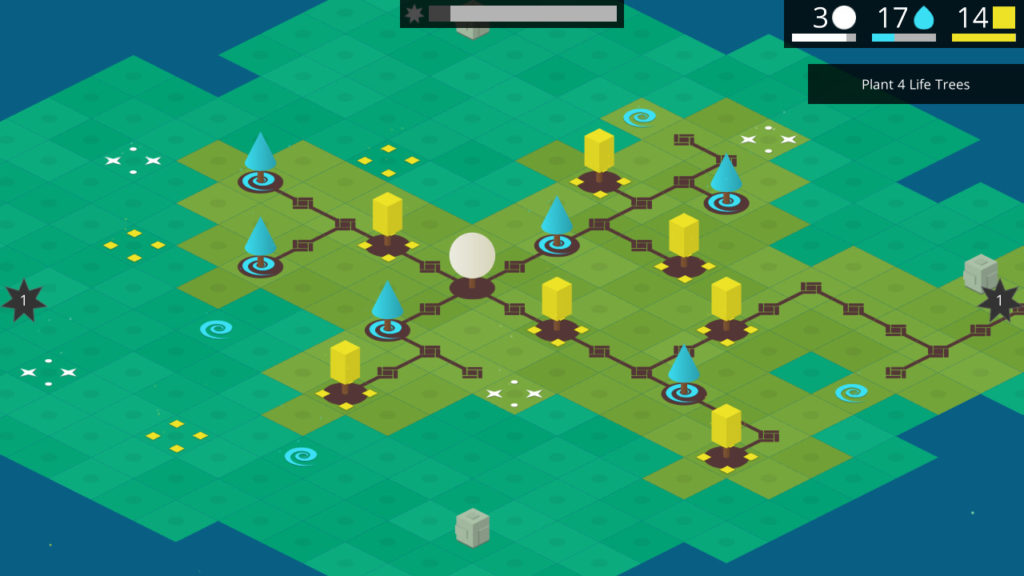
Time management and spacial awareness are the two most important skills to have here. Since you need an equal amount of water and minerals to make anything, it may seem like the best course of action is to try to keep the number of water trees and the number of mineral trees equal, but it’s not quite that simple. First, trees each contribute to decreasing the amount of time it takes to create one unit of their respective resource rather than individually producing resources so the impact each tree has on the rate of resource production becomes more significant when you have a larger number of trees for that resource. Secondly, seed production is much, much slower than water and mineral production and paths cannot be built directly on top of resource nodes without creating a tree, which creates situations where you will have to choose between which resources to expend more of. For example, you may want to create a tree on a water node where the shortest path to it cuts across a mineral node so you would have to decide between spending a valuable seed and slightly more water and minerals to plant a tree on the mineral node since you’ll need it in the long term anyway or to hold on to the seed and build around the node, at which point it becomes important to consider which side is more efficient to build on in the long term in regards to other node locations. However, the biggest factor to consider when building paths and claiming nodes is combat.
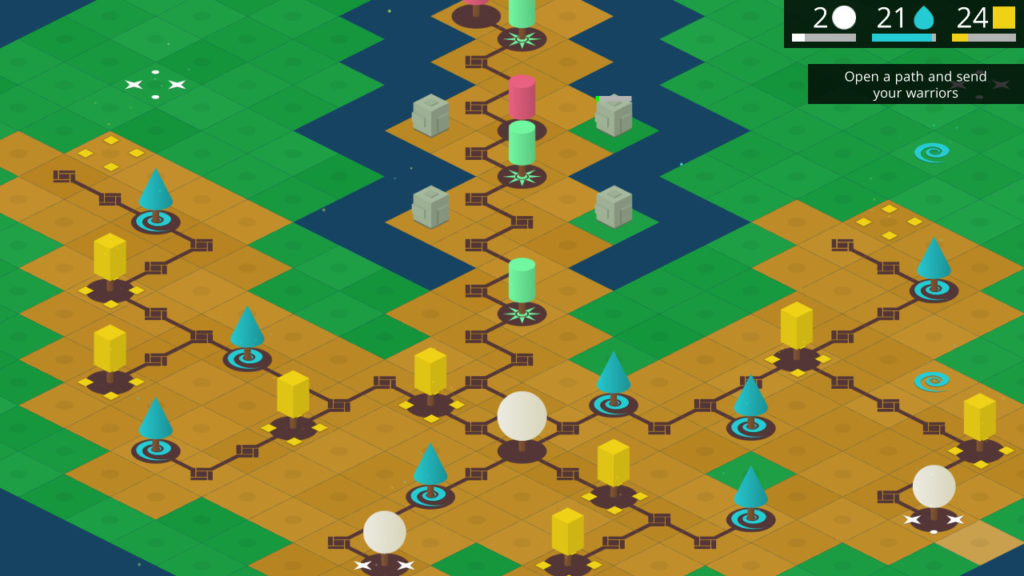
Combat is fittingly passive in Nanuleu and works surprisingly well. The first map of the game has enemy-spawning trees gradually appear from the edges while the second and third maps feature a single base which grows over time. For now, I’ll be focusing solely on the way combat affects the flow of the game in the first map. In this scenario an enemy tree appears in one of the corners after a bar fills, another tree will appear in the opposite corner after the bar fills a second time, and this will continue until all four corners and then all four sides have had a tree spawn in them. Individual trees produce units slowly, but the number of trees in each base will gradually grow unless the base is destroyed. Unfortunately for players, the ‘war trees’ which allow you to produce units of your own can’t be grown on the path or next to it until all four life tree nodes have been claimed, each of which slightly boosts seed production and has the considerable cost of one seed and 20 units of both water and minerals. To further complicate matters, you only lose if your main tree is destroyed, but there is a bonus objective to defend the four shrines, each of which is a somewhat fragile structure placed near one of the corners. Though you may not initially be able to make units of your own while the enemy forces continue to grow and surround you, you are also not entirely helpless as you can still plant stationary defensive trees which will periodically fire bullets at enemies near them and which enemies in turn will prioritize attacking over shrines as long as the shrines aren’t too far away from the trees. In addition to helping with seed production and eventually unlocking war trees, life trees also send out a wave the first time they are build which destroys all enemy units and fully heals all of your own trees, which can turn the tide if you need to buy a little more time. Thus, while you may want to expand in every direction to quickly connect to as many resource nodes as possible, it’s even more important to make sure you have enough resources to build a path out to any corners enemies have appeared in in order to defend both the shrines and the path itself as any tree cut off from the path becomes inactive while also making sure to gradually work towards growing the life trees. The end result is a sense of pacing which feels relaxed as you wait for your resources to become high enough to grow another tree, but also frantic as you must expand your base as quickly as possible while constantly creating new defenses to stave off the ever-growing threats attacking from every direction.
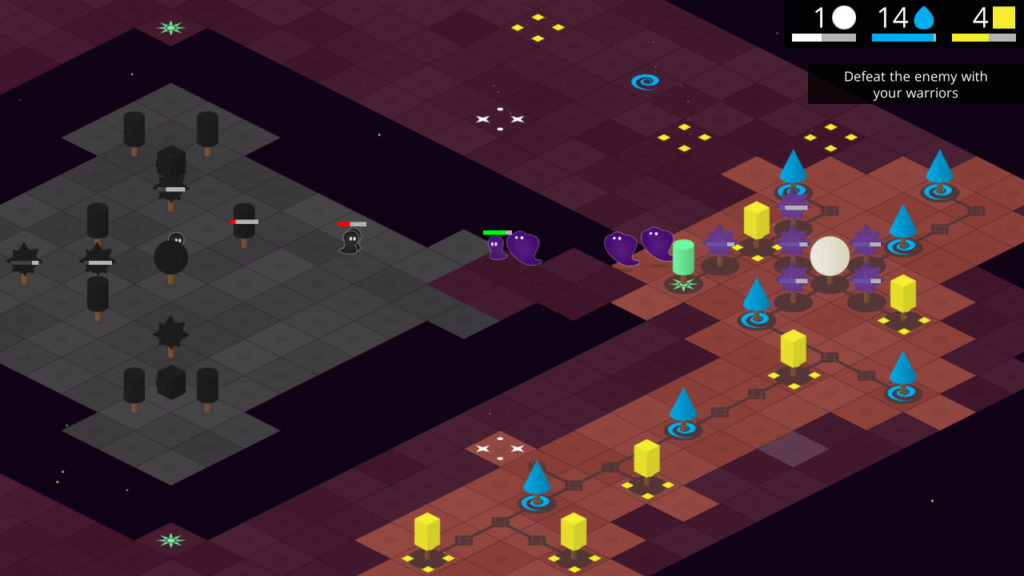
There is an almost surreal sense of passivity to the combat which contributes heavily to creating that ‘tree feeling’ I mentioned near the start of this article. You never have direct control over anything in regards to combat. You can build a defensive tree near an enemy base and it will attack enemies near it, but you can’t command it to attack a specific enemy in a group. Likewise, you have some influence over the units which your own war trees produce based on where you decide to plant your war trees as they will always prioritize the enemy units and trees closest to them, but you can’t otherwise tell them to perform specific tasks such as ignoring enemy units to focus on taking down a tree or waiting in your own base. Even the two unit types themselves have an air of passivity about them; the standard units are small, phantom-like creatures which slowly drift along and periodically attack with energy bullets and the ‘stronger’ units resemble snakes and wrap themselves around trees and units as an aura which gradually drains away health and makes their target incapable of attacking. As victory or defeat is largely determined by how effectively you built your paths and spent your resources near the start of the level, The last minute or so of a match usually involves sitting back and watching as an insurmountable force of either your own units or those of the enemy drift along the map methodically eliminating their foes. The aesthetics further enhance this sense of inevitable, merciless passivity at the end of each level with the minimalistic, stylized graphics and the calm, repetitive, almost meditative music which plays over the occasional, brief sounds of energy bullets being fired and trees being destroyed. There is a lot of downtime in the gameplay between periodically waiting for one resource or another and watching as one side or another clearly gains the upper hand at the end and normally this large amount of inactivity on the part of the player would make for a terribly boring game, but here everything comes together and just feels right; this is a war between sentient forests and, as such, it is outwardly calm while being as utterly merciless and secretly frenzied as nature itself.
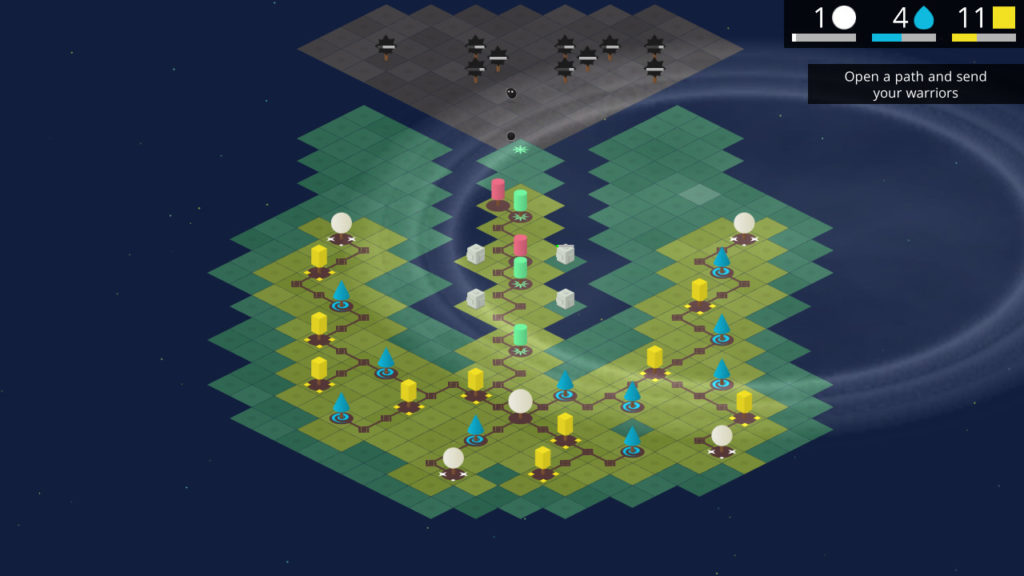
Before this article comes to a close, let’s take a moment to look at what might be a make-or-break point for some – the maps. This is an issue which falls firmly into that hazy grey territory so I’ll start with the negative. With three levels at the current price of $2.99 the cost comes out to about a dollar per level, which is actually a fairly good ratio of levels to dollars by RTS standards. However, these are also very short levels by RTS standards, short enough that they each have an optional objective to win in under 15 minutes, and there is no multiplayer to speak of. The game also gives off the impression of being something of a prototype with how these levels are structured. The first level has you defend a central base from outside attackers, the second level has more of a sense of balance with both you and the enemy having bases on either side of a lane, and the final level reverses the initial roles by placing the player on the outside to gradually expand and surround a central enemy base and destroy its shrines; there is variety here, but it feels like it is comprised of scenario types begging to be expanded upon in a more fleshed out sequel.
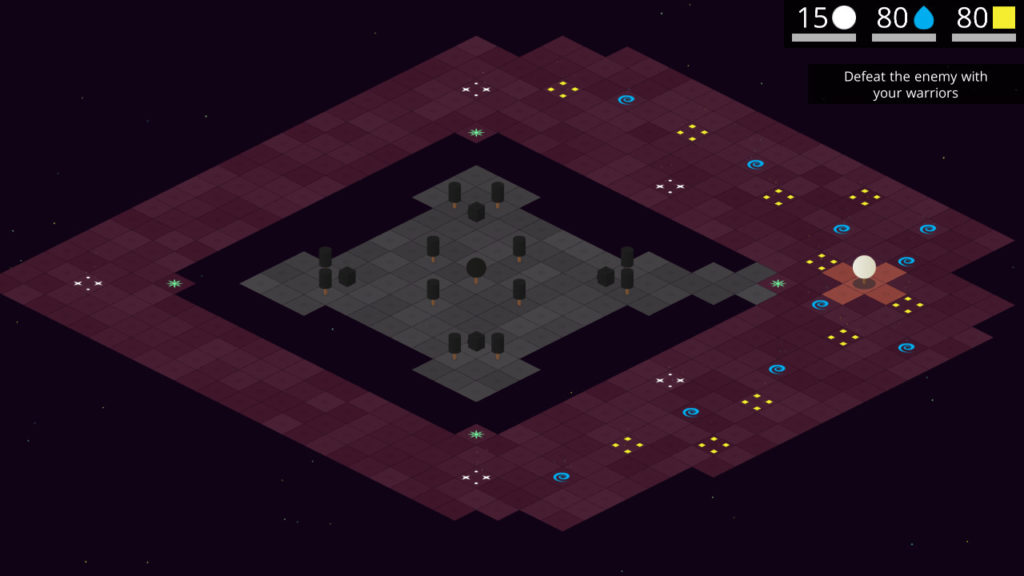
On the other hand, even if I would love to see the scenarios presented by Nanuleu built upon in a larger project, they all still hold up well on their own and there is a smooth narrative flow reflected in the gameplay of going from being on the defensive at the start to turning the tide and pressing the attack in the final level where you can build war trees right from the start. Every level also has two difficulties tied to it, plus a third difficulty setting on the first level which largely serves as a tutorial, and the differences between these difficulties are seemingly small yet substantial. On top of the enemy bases growing faster, life tree node locations are modified and the map layouts are changed; gaps around the shrines in the first level make it more difficult and more expensive to defend them, the path in the second level is split into two smaller paths, and the opposite corner in the final level has virtually nothing on the way to it life tree node, making it extremely expensive to build and defend a path leading to it. The relatively short duration of each level also works in the game’s favor as it usually doesn’t take too long to realize if you have made a fatal mistake and the partially randomized resource nodes combine with an online leaderboard (points are primarily based on time taken and trees lost) add in a strong element of replayability which is rare for the genre. Overall, I think the positives far outweigh the negatives here, but the lack of multiplayer and the low amount of content may make this a harder sell for some.
Nanuleu ultimately makes for a uniquely, fascinatingly passive RTS experience. It may be small, but I found it to be immensely satisfying throughout and it deserves praise for executing so well upon such an unusual and risky concept.